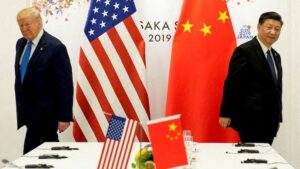
China has dramatically increased retaliatory tariffs on U.S. imports, raising the rate to 125%, in a move that further escalates tensions in the ongoing trade war between the two global powers. The announcement comes as Chinese President Xi Jinping delivered a pointed warning to U.S. President Donald Trump.
The dispute intensified this week after President Trump implemented tariffs of up to 145% on Chinese imports, effective April 9. In response, Beijing raised its own tariffs—previously increased to 84%—to a staggering 125%, signaling a deepening economic confrontation.
The two leaders, President Trump and President Xi, have been locked in an increasingly hostile trade battle since Trump returned to the White House in January.
While announcing the latest hike, the Chinese State Council Tariff Commission released a strongly worded statement on April 10, condemning the U.S. actions as “unilateral bullying and coercion.” The statement criticized the tariffs as a violation of international trade rules and economic principles.
> “The U.S.’s imposition of abnormally high tariffs on China seriously violates international economic and trade rules, basic economic laws and common sense,” the commission stated.
Effective April 12, 2025, China’s tariff on U.S. goods will increase from 84% to 125%. The commission noted that the current tariff level has severely reduced market demand for U.S. products in China.
> “Given that at the current tariff level, there is no market acceptance for U.S. goods exported to China, if the U.S. continues to impose tariffs on Chinese goods, China will ignore it,” the statement warned.
The statement referenced Chinese laws and international principles to justify the tariff hike and reaffirmed previous regulatory frameworks under the State Council’s authority.
The trade war traces back to Trump’s first days back in office. On February 4, he signed an executive order accusing China, Mexico, and Canada of contributing to illegal immigration and drug trafficking into the U.S. A 10% tariff was subsequently imposed on all Chinese imports.
China retaliated swiftly, implementing a 15% tariff on U.S. coal and liquefied natural gas, along with a 10% levy on crude oil, agricultural machinery, and large-engine vehicles, starting February 10.
Since then, both countries have ramped up economic measures, leading to the current situation: China enforcing a 125% tariff on American goods and the U.S. taxing Chinese imports at rates up to 145%.
The standoff shows no signs of de-escalation, raising concerns globally about the broader implications for trade and economic stability.





